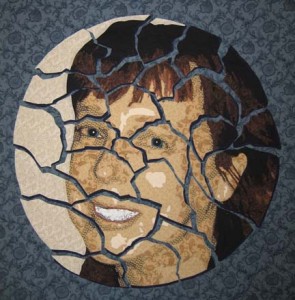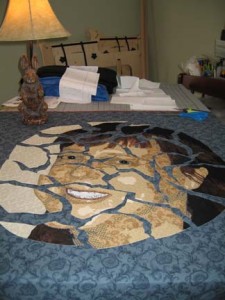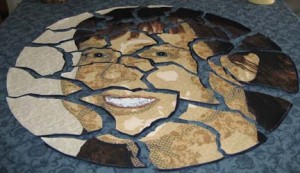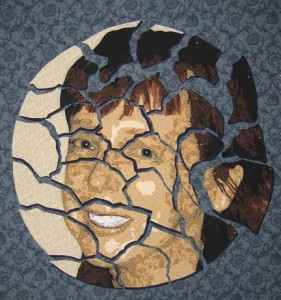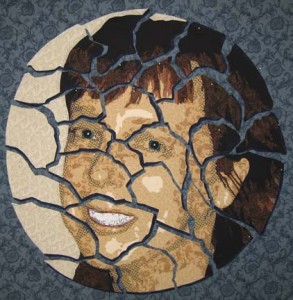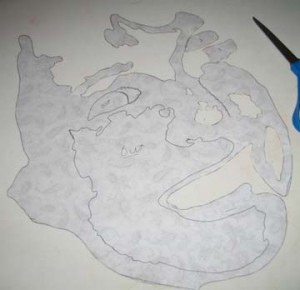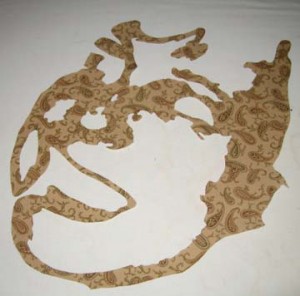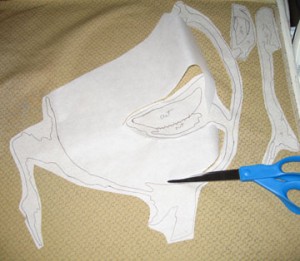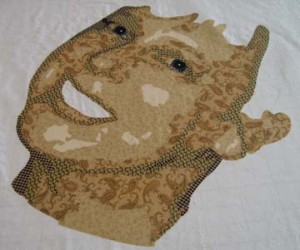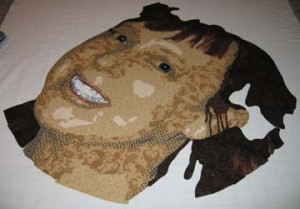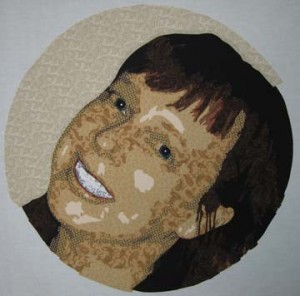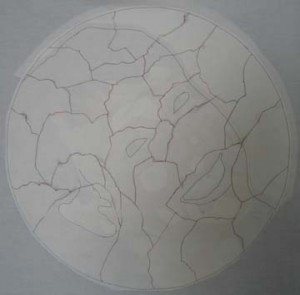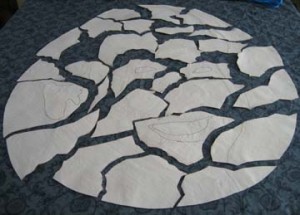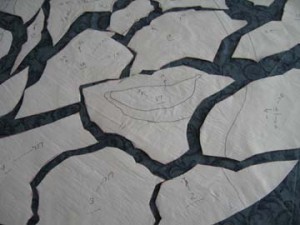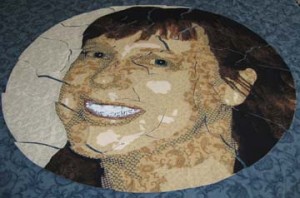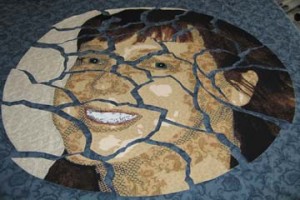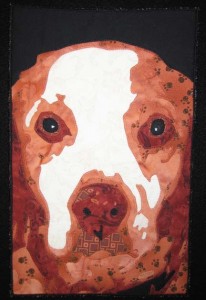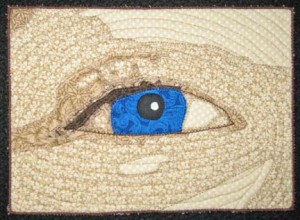Virginia Greaves
(7 comments, 341 posts)
This user hasn't shared any profile information
Home page: http://www.virginiagreaves.com
Posts by Virginia Greaves

Irony
0Irony is that the hottest thing on my blog about quilting is the entry I made on zentangling last summer. And I mean by a lot.
Irony is cutting up the face — only to then begin to realize how much harder it makes everything. There are a lot more lines to applique — and now I’m starting to dread quilting this thing. All of the applique is finally done — and I printed out a B&W picture of it to start penciling quilting ideas — and it hit me. All those stops & starts. What was I thinking?
Cutting a piece up causes all kinds of unexpected problems. I also had a problem with the white backing layer (on each of the individual plate pieces) showing up between the dark colors and the now blue background. I used a black & brown micron pen on the edges which did a fairly good job of making the white go away.
So this relatively small piece has become infinitely complex.
I also starting to think that it needs something more. I’m not a big fan of borders — I’ve been using the plain small band of black on the binding for years. However, I recently hung Duodecim in my dining room — and it could use more space between the image and the wall. The black binding is not enough. I’m so used to seeing things on my black design wall — I tend to forget that most walls are lighter in color.
So I played with this in Photoshop & I think I’m going to add a narrow black border, then a couple inches of the dark blue used to shadow the plate pieces, and then finish with the black binding.

Taking Care of the Little Details
1Now that I have it constructed & de-constructed, what more could there be? Well, it occurred to me that it might be cool to add a drop shadow to the pieces — to give the illusion of the plate pieces on the surface of the table. I really had no idea how to do that. It’s easy in Photoshop — well, in the latest version it’s in a new place, but it’s just a few clicks away once you know where it is. And in Photoshop, it is a fairly subtle illusion — I’m limited by the solidity of fabric to create my illusion — which is more solid than scattered pixels.
It occurred to me that I could take a small lamp (I used a rabbit lamp from one of the kid’s rooms) and lift each piece to see where the shadows would fall.
Then I marked each piece with a blue line on the sides where I wanted to add a shadow.
Then I carefully lifted the paper backing from each piece — and used that as the template for another fusible template for only the lines I wanted to shadow. It didn’t need to be exact — this is about creating suggestion — and I only needed 1/4″ or so to tuck under the larger pieces.
Here you can see all of the pieces with their shadows — except it is on a flat surface & a little hard to see at this angle. If I were taller or my table were shorter, it might have worked, but I wanted to have a better angle for judging where all of the pieces would ultimately sit on the background. I took masking tape & lightly taped the pieces to the background — transferred the whole thing to my design wall — and then replaced the tape with less obtrusive pins.
This next part is more maddening than I expected. There are a lot of different looks you can get depending on the space between the pieces — and all of the pieces are interdependent so if you move one, you have to move several. At one point, I put them all tightly together so that I could regain the relationship between the pieces because I don’t want to entirely lose that when I pull them apart.
In this incarnation, I pulled the head pieces a little more askew & out. Unfortunately, because I used a variant of white in the circle portion of the portrait, it created a piece that then pointed outside of the piece — which is not the direction I want the eyes of the viewer to go.
I think that this is what I’m going to stay with. It shows all of the pieces still in relation to each other without any one piece wandering off, and yet the pieces are still distinct and apart from each other.
I like the effect of the drop shadow. It isn’t overly obvious that it is there, but it creates a depth in the piece that wasn’t there before.

Not All It’s Cracked Up To Be
1My latest face is rather small — but my intention when it’s done is to cut it up. I know I know — but it’s time to do something unexpected.
To start, the face is made the same way. This pic shows the first 2 layers. Since I’m ultimately going to make an applique out of the entire thing, I’m much more careful with my layers so that I have as few of them as possible. I put down the 1st value — and then the 2nd value with cutouts for reverse appliqueing the 1st values.
I thought I would show what the cutting out looks like. This is the back of the 3rd value with some large areas still left to be cut out.
This is it cut out entirely. The 3rd value in the face tends to be the most complex.
I thought that I would mention that you can really screw up these complex shapes. If you draw a deep curve onto the paper backed fusible, cut it close to the lines, then fuse it, cut it out & try to apply it — it can get really wonky. Sinewy lines won’t lay flat when you fuse them & thus when you try to lay out the fabric, it won’t lay straight on your design. So there are times that it is best to leave big empty spaces in the fusible. You don’t want to fuse them down — that would be wasting fabric — but you can fuse down the lines you do want & use the big spaces to help you lay your design flat while you are fusing. Then you cut away the excess fusible.
These are the 4th & 5th layers.
And now the eyes.
Then I added the mouth & started on the hair. There are only a few pieces of the 1st layer of hair — so this pic shows the first 2 layers.
Most of the hair is made up in the 3rd & 4th layers.
And then I finished the piece with a background. I wanted something circular in a fabric that wouldn’t distract from the hues in the skin but that would work well with the background blues I’m going to add. Since I’m going with the idea of a plate, it made sense to go with a stoney white. It doesn’t compete with the yellows in the face or make it seem that the face is bleeding into the background. It will give a good contrast to the blue but not draw too much attention.
And now comes the scary part. I draw my circle onto Wonder Under and using my pattern, draw out the outline of the front of the face, the two eyes, and the mouth. I try to place the Wonder Under approximately on top of the corresponding elements. I prefer not to cut through the eyes and the mouth.
Now, how do I draw the lines to make it looked cracked? Hmmm — well in Photoshop, it’s fairly easy to use the magnetic lasso tool so I can estimate what it is going to look like — but I have to take a leap of faith & a pencil & draw my cracks onto the Wonder Under. When I’m happy with it, I draw over all of the lines to cut in red to make sure I don’t try to cut one of the guide lines I drew earlier.
This is what the front looks like with my neat circle cut out.
I then turned it over and (gulp) started cutting. It helped that I couldn’t see it as I did it. (I did in fact cover this piece as I worked on it for fear that someone in my house would grow attached to it before I cut it up & give me grief for sacrificing it.)
It was then that I started thinking about turning it over. You can see that it is sitting on the background blue fabric that I picked out — but you can’t just turn each piece over. It is a mirror image — so things on the right have to be moved to the left. I started worrying about putting it back together again — so I numbered the pieces on the back with hints to the pieces that bordered each other.
Then I stacked them all up by number, turned them over, and laid them back down as close as I could to make the puzzle pieces match.
And then I pulled the pieces apart so you could really see the cracks.
I spent today adding a drop shadow to the pieces in a dark blue so that they look dimensional. I’ll show that later. I got it all up on my design wall and I’m second guessing the placement of the pieces before I fuse it all down. (I fused the drop shadows on a teflon sheet so that I could attach them to their pieces but keep them loose. This way I can play with them on the design wall.)
Part of me wants to start sewing immediately, but some perspective might help the overall design. There may be another way of presenting this other than what I’ve all ready considered.

Re-Connecting
0I confess — I haven’t written in quite a while — for many reasons. I stopped most all studio work after Thanksgiving in order to prepare for Christmas. It felt good to have all of my things done & properly prepared — but I also really missed the studio. I thought about my sketch book — even carried it around — but didn’t really work in it. I’ve also been letting Facebook take more of my life than I should. I think in the new year I’m going to limit my access.
I did make a small piece for my husband as a gift — it’s made from a picture of his dog Solomon. I made one of Solomon last year and gave it away in my fiber art group’s annual 5×7 exchange — and I didn’t realize how much that bothered him until it was all ready done. So this year I tried to make it up to him by making this small piece (Solomon II):
Not easy finding commercial fabrics in rust but I think I did an OK job. I even used a print with paw prints on it — which I think works out OK given Solomon’s age. He is a Brittany Spaniel & his life expectancy was 10 — he is 19 and still going strong.
I also had the complication of a new computer — on a new platform. We had an XP PC that was over 7 years old & it was making noises like the hard drive could crash any minute. We looked at new computers — and in the end bought an iMac which is SO much faster. There are new things to learn though — and the files aren’t as compatible as I would like. Microsoft Office files ARE compatible with the Mac — but hey, not all Microsoft WORKS files are compatible. Add in the fact that the CD writer on the old PC doesn’t always work. I finally brought over all of my old pictures using an external hard drive. I also set up a wireless network. I had tried for a VERY long time to do that with a DLink router — and it never worked — but the Airport Time Capsule set up like a dream & works with Macs & PCs.
My last technical struggle involves software. I use Photoshop A LOT — and CorelDraw to resize my patterns — and DreamWeaver for my website. I did upgrade Photoshop on the Mac — haven’t decided yet about DreamWeaver. I’m thinking about putting my entire website in WordPress. It’s been years since I’ve changed the look of it — may be time for a change — and WP is great software.
Once I got Photoshop on my Mac — and my pictures — I could start figuring out a new piece. Hmmm — not much to work with. I really need to dedicate myself to taking more pictures and maybe taking a photography class.
I have had an idea pinging around in my brain for a while. It involves doing a portrait — and then cutting it up to make it look like a cracked plate. Can I do that? Can I cut up a portrait? After thinking about who would be cracked — I decided that the answer could only be me. Although we always talk about how crazy other people are, everything is relative to ourselves — and you can’t deny that it’s possible that everyone else is sane & I’m the one that’s cracked.
I think that I just need to move away from my comfort zone of a straight forward portrait. Test some boundaries. Something maybe realistic with the unexpected thrown in.

5×7 Is Really Small
1My Fiber Art Fusion group has a holiday exchange in December of a 5″ x 7″ piece of art — which sounds really easy — probably won’t take a lot of time. But actually, I find it much harder to work small. When you’re used to working in a particular scale, going far from that can really throw you.
Which is to say that my first piece totally bombed. I tried to do a 4 value beach scene in black & white — three people in the surf with their backs to the viewer. I think that it is a good idea for a piece — but it really needs to be larger. Lower the # of values was not enough to make this simple. First there were too many really small pieces needed to evoke the surf — and second, all of the fabric prints had to be really small scale for it to work. I thought I had a handle on that — but I wasn’t thinking small enough. At some point I realized that I was at a point of diminishing returns and I stopped.
At this point, I thought about just doing an eye — it is a shape I’m familiar with and enjoy doing and its creation would help me grow in my work by concentrating on one small yet very important part of portraits.
It’s made me think that I should spend some more time studying just the eye. It is done differently than in my portraits and although simplified, I like the broader use of color. I may spend the time from now until the holidays working on small eye studies.

How to Quilt a Face
7When it comes time for me to quilt, I usually have a fear of starting. Most people don’t quilt the face at all — but my entire quilt is a portrait and I have no choice but to quilt it. And let’s face it — the trend at shows is close quilting. I have tried sparsely quilting faces — and the judges don’t like it. I’m not saying that you have to make your choices based on what the latest trends are, but I do think that judges are following the trendsetters when they are judging & jurying — and close quilting has become the norm. (Stitch regulators too — but I won’t even go there. I don’t personally care too much about stitch length — I’m creating art not a bed quilt. I guess this is where I draw my line.)
The easiest thing for me is to take a black & white picture of the model, grab & pencil, and start drawing away. I can erase anything I don’t like — it isn’t permanent & doesn’t involve ripping out stitches. I do try to follow what I consider to be the contours of the face so that the quilting itself will give dimension to the face. I follow the contours of the applique sometimes — and completely ignore them at other times. There are no rules — just my imagination.
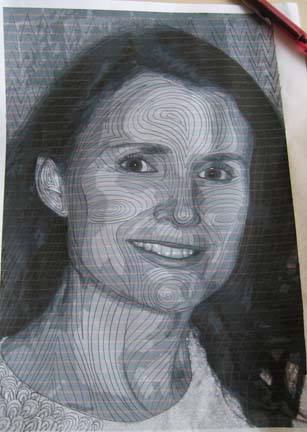
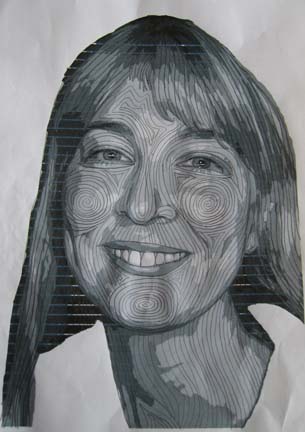
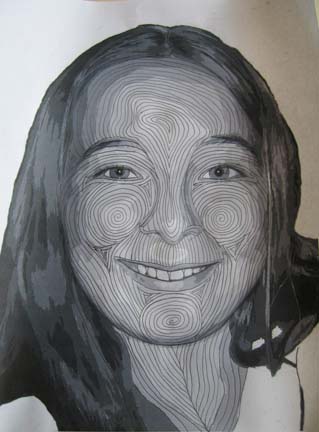
I show three pictures to give you an idea of how I might change things depending on the pose — or what things are more similar. To be honest, I have found it easier to take out previous photographs and see what I have done before I start. I have also found it easier to do something else while I draw on the photo — like talk on the phone. I tend to be more creative that way & not as likely to second guess everything I do.
I used to transfer most of my lines to the actual quilt before starting using a blue or white erasing pen. Now I transfer very few lines — only a few guidelines as I go — and the forehead which is generally based on the applique of the lightest color. If I quilt from the outside in, I get a big poofiness in the middle (ask me how I know) — so it is generally just easier to draw it out & then quilt on the lines.
I quilt about 1/4 inch apart so poofiness can be a big issue. I pin the whole quilt before I start & try to quilt from the inside out as much as possible. When I get to the outer borders of the head, I’ve pushed quite a bit of fabric out to the edges — so I’ve learned the hard way not to outline the head first — save that for last. I also tend to smooth out the fabric in the background & move my pins to accommodate the moving poof — pushing it out to the edges — before I start quilting that area.
There is stretch that goes on when you quilt that close — both in the top and the batting. I use the 70/30 Quilter’s Dream batting. There is a scrim side I used to always face to the back because it has some cotton imperfections — but one day I made a mistake & put it scrim side up facing the top — and I’ve had a lot less waviness when I’m done quilting since then. I’m sure there is a rule somewhere about scrim up or down that I’ve never heard. But this is what works for me.
I have finished this one — decided to name it Duodecim which is latin for twelve. I’ve always thought this was the perfect age and have always felt that age in my heart. This is the final pic but there are more detail shots on my website here.


What To Do When You’re Not in Houston at Festival
3The International Quilt Festival is going on this week in Houston. I was lucky to have two quilts juried into their World of Beauty exhibit this year, Adelpho and Unconditional. Unfortunately, I will not get to see them hanging. My quilts travel more than I do. When my husband retires and the children are grown and gone, I hope to go to more shows.
I also had two quilts recently in the East Cobb Quilt Guild: Georgia Celebrates Quilts biannual show here in Atlanta, Sweet Dreams and Shoshanna. Shoshanna won Judge’s Recognition and 2nd Place in the Original Design category.
(Interesting side note — I took my friend that modeled Shoshanna to the show so that she could see it hanging. After the show, I had several quilters tell me that they had seen the woman at the show that looked like the quilt, and I of course assumed that they were talking about my model. Then I received several emails from a woman that had gone to the show earlier in the day and looks a lot like the quilt and hence the model. This is the first time I’ve had this happen. Unfortunately, the visitor to the show really wanted to meet the model, but I couldn’t violate my friend’s privacy.)
As this has been a banner year for me to be in shows (which makes up for only being in one show last year), I am also honored to have two quilts in the Art Quilts XIV: Significant Stitching show at the Chandler Center for the Arts in Chandler, AZ starting in November. Sweet Dreams will travel as will Chameleon.
Enough about me. I haven’t posted in a month and although family obligations keep trying to derail me, I have actually made some progress on a new piece. I’ve been taking a lot of pictures and I’m getting ready to quilt it, but since I’m procrastinating, I thought that I would show you the development of the face. (Keep in mind that all of the pictures except the last two were taken of the piece on a high table — and I’m a short woman — so there is some distortion in the features.)
This is all about layering values. I always (well I do now anyway) start with the lightest value in the face. In one quilt, I used the 2nd value first — and had show through which drove me nuts — so unless the piece of fabric is fairly small, I put down the values from lightest to darkest (which, by the way, is the opposite of how Deidre Scherer does her faces, but she free-hand cuts everything).
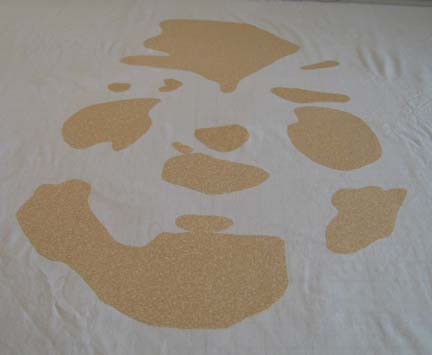
The 2nd value for the face is a bold choice — I admit it. I was pushing the limits of what I thought I could get away with. It is a paisley with tan, stone, and orange in it. There are even some hints at white. I had actually bought this for another quilt & didn’t use it — but the subject in this one is more carefree so I thought I might be able to pull it off.
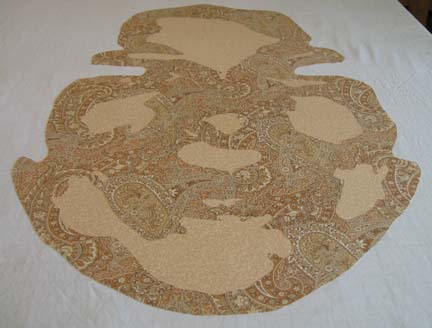
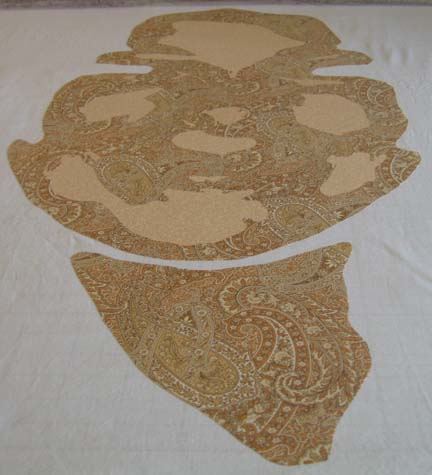
The next value is a tan and blue stripe — but it is more tan than blue so I knew it would work for shading. I worked so hard to make the stripes vertical — and when I was done I wished that I had placed them on an angle. Maybe next time.
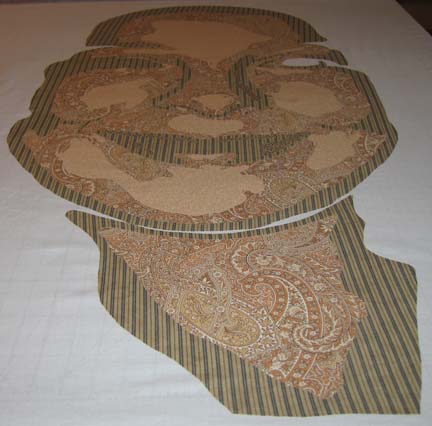
The next value is a little harder to see in this picture — but it is a tan with a small blue floral print. Again — it works for shading.
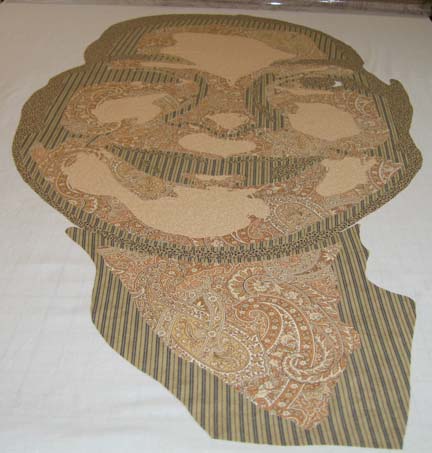
The next value — I’m really pushing what I can find in values — is a small stone and black paisley print — very busy. The stone is too light but I figured that the density of the black will overcome this flaw.
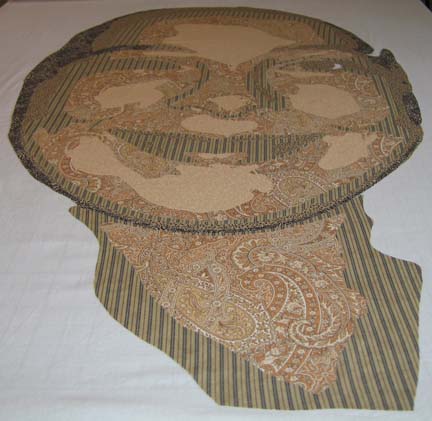
The last value for the face was found in my brown drawer of fabrics. It is a dark taupe with black and helps to outline the eye and the eyebrows.
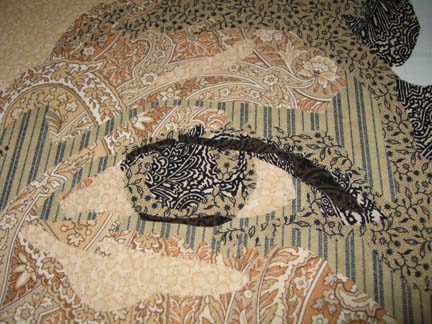
Here you see that I have not added the eyebrows — I got distracted & started working on the eyes. I originally chose a gray blue for the pupils which you will see later I had to change.
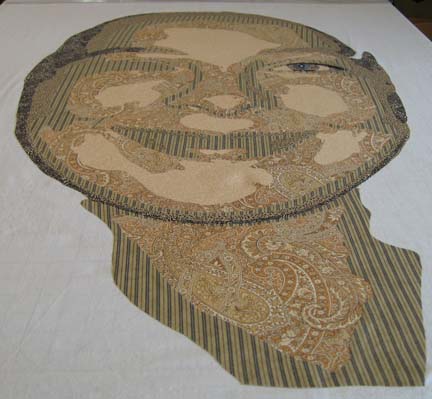
Here are both eyes with the eyebrows.
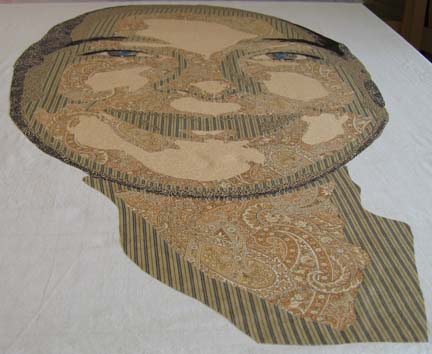
The crowning touch is of course the mouth. It has a red border which signifies the inner edge of the mouth — and the mouth itself with the teeth are constructed from values of white — and by that I mean from white to gray using prints with varying densities of pattern to vary the value. (I do admit that I straightened the teeth of the model. My mom, an oil painter that has done a few portraits, agrees with me that most models like their features to be represented as better than they truly are — regardless of what the mirror tells them.)
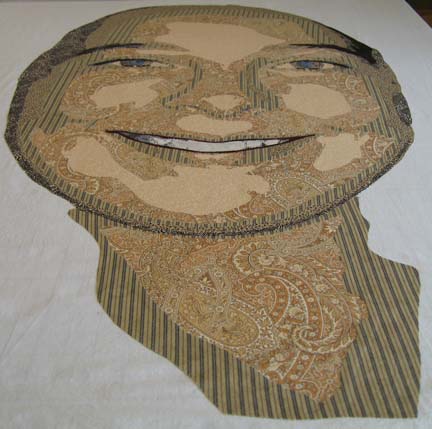
At this point, I start on the hair. This is the first value of brown.
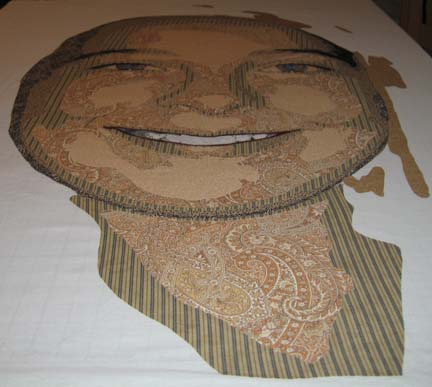
This is the 2nd value — not coming together yet.
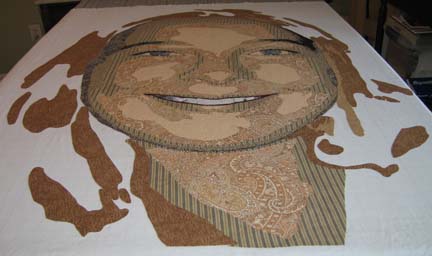
The 3rd value is where most of her hair starts to come together.
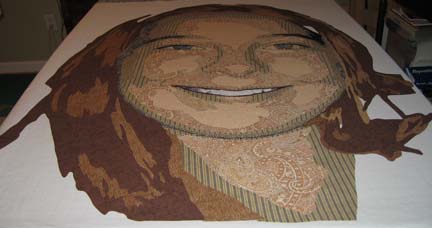
This shows the 4th value of hair.
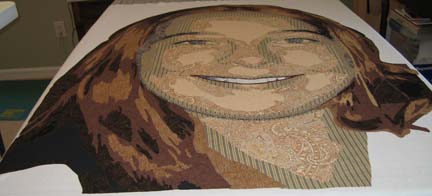
This is the final applique before I start adding the background. I have added some black in the hair — and the eyes need to be changed. The color isn’t strong enough — and they need more work.
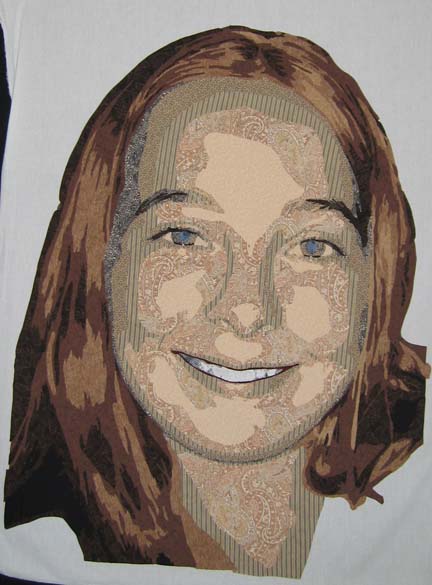
Here I have changed the eyes to a stronger color — a green/blue which is actually the back of the fabric used in the background on the left side of the picture. I had a really hard time with a background for this piece. You want it to support but not detract from the piece — or call too much attention to itself. Again, the fabric I used for the T-shirt is a bold choice, but I wanted something playful to represent the youth of the model. I drove all over town (aren’t I lucky to finally live in a place that has a bunch of fabric stores?) and couldn’t find anything for the background other than the T-shirt fabric. I ended up pulling 2 fabrics — one from my green drawer and one from my blue drawer — which just goes to show that you should never limit yourself by how you or someone else has classified the fabric.
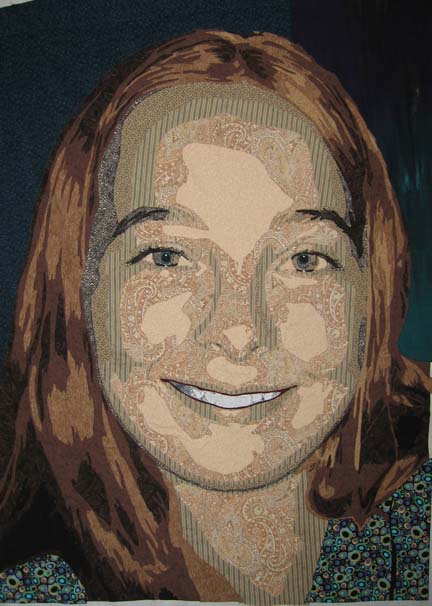

Exhibit Visit
1As fate would have it, I was unable to attend the opening reception for Fiber Art Fusion’s Exploring Dimension exhibit. I did, however, visit it with my mother the following week. We also visited the High Museum — and although the visiting exhibit from the Louvre was good, we had seen it before — and the permanent exhibit was, in my biased opinion, not nearly as good as FAF’s exhibit.
I have received permission from some of the artists in FAF to give you a sneak peek — a small tour of the wonderful treasures on display at The Art Place.
This is my piece, The Price of Passage, which I include since I added something since I last took pictures of it. Can you tell what it is?
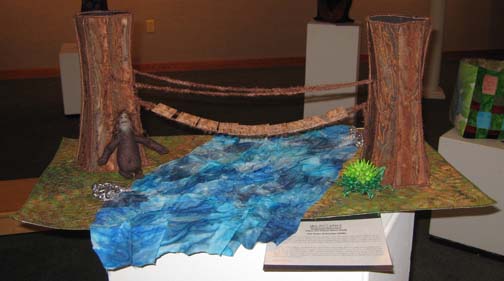
The Wailing Wall by Denise Webster – Some of the stones have photo transfered pictures on them. There are also little notes tucked into the nooks & crannies between the rocks.
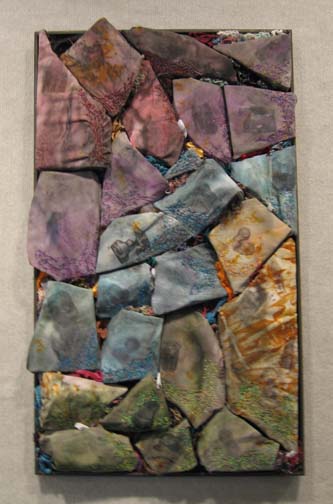
Blue Vessel by Sharon Ahmed
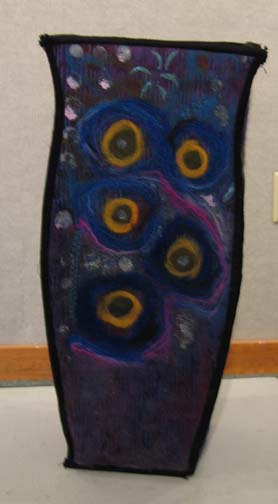
Felted Vessel by Sharon Ahmed
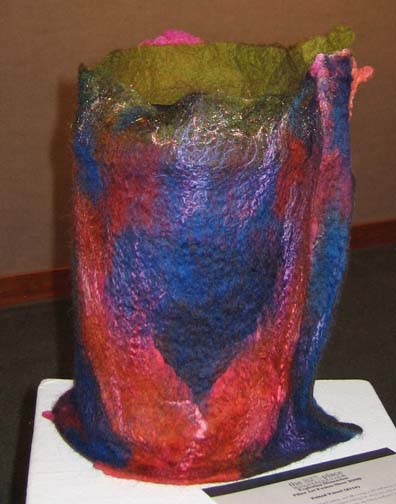
Dancing with the Dragonflies by Sharon Ahmed
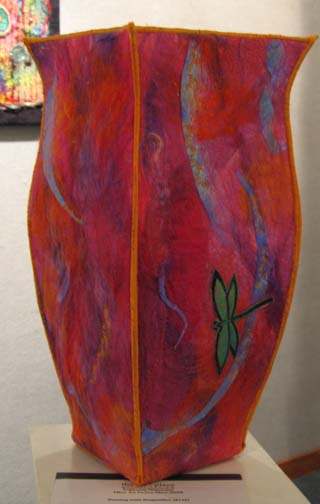
Felted Monsters by Sharon Ahmed – All of these are made with felted wool.
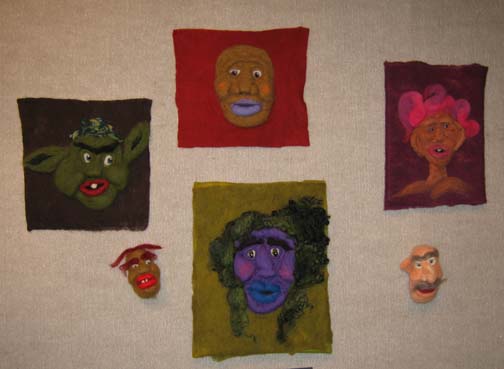
Do You See What I See? by Wendy Blanton – This is Wendy’s interpretation of a migraine headache – and the black & white road actually protrudes from the eye.
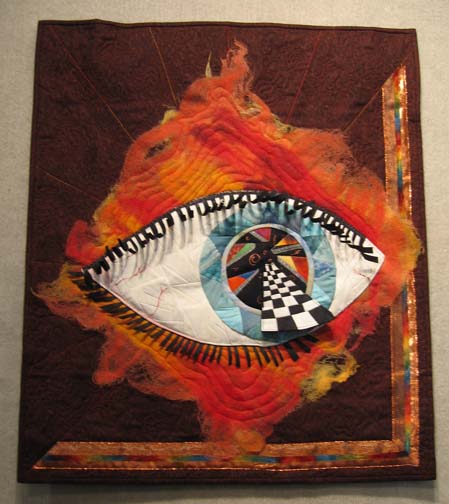
Reuse by Julie Kokan
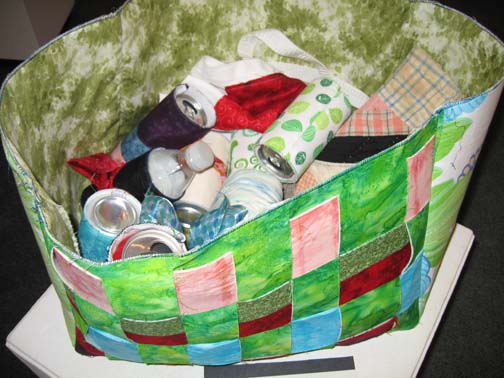
Dragon Flight Plan by Margaret Betz
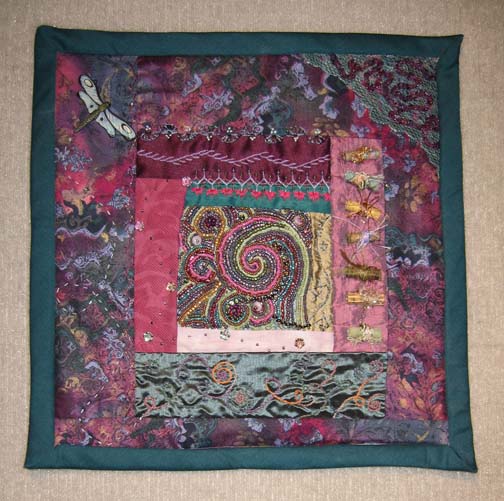
Dream Weaver by Margaret Betz
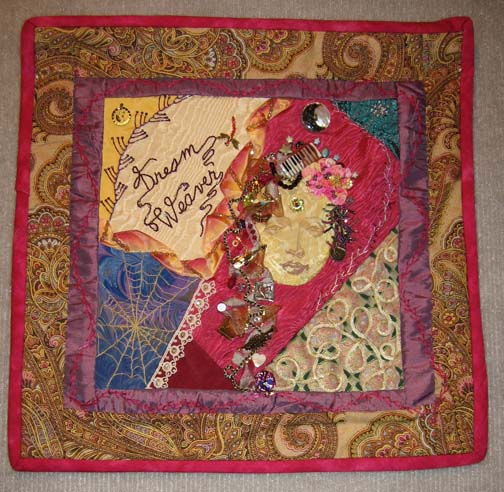
Treetop Reverie by Margaret Betz
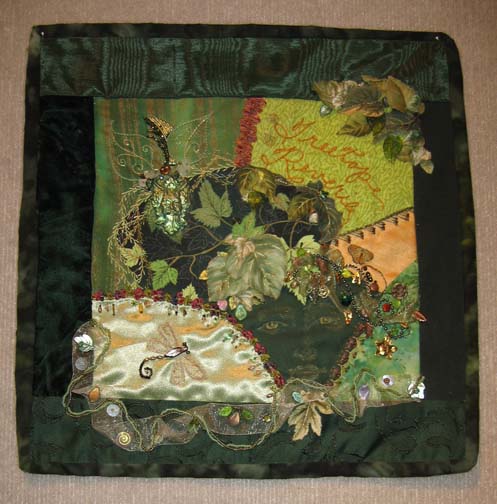
It Ain’t Over by Rebecca Reasons
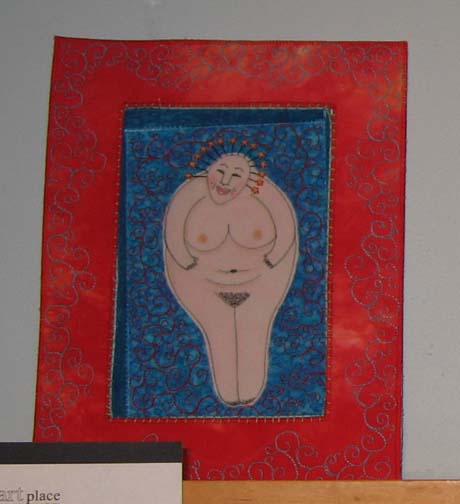
Blue Box by Rebecca Reasons
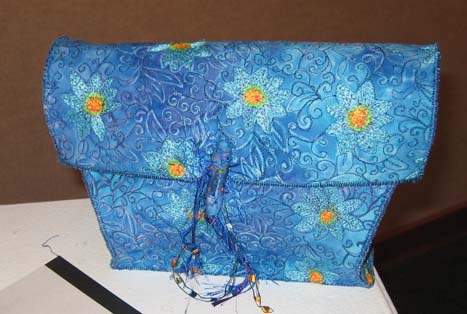
Hawaiian Tea Time by Diane Schulteiss – Diane used watercolors to paint the painting, and then used photo transfer techniques to make her own fabric which she used for the tea set.
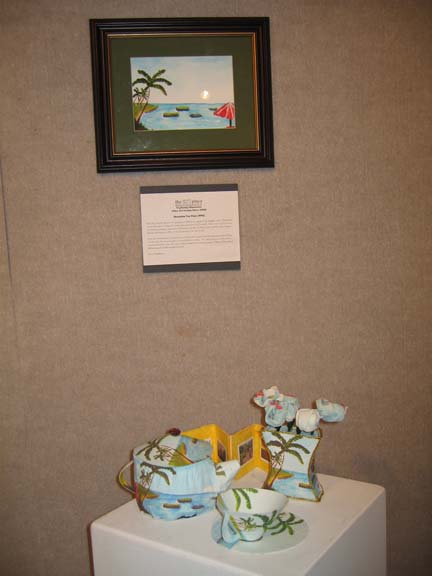
Share the Spirit by Diane Schulteiss – This one was difficult to photograph as it has the image printed on organza in the foreground and also printed opaque in the background.

Ethereal Summer Day by Ann Quandee – This one has a lot of sparkle — as you can tell, my camera and I had a hard time taking a clear picture.
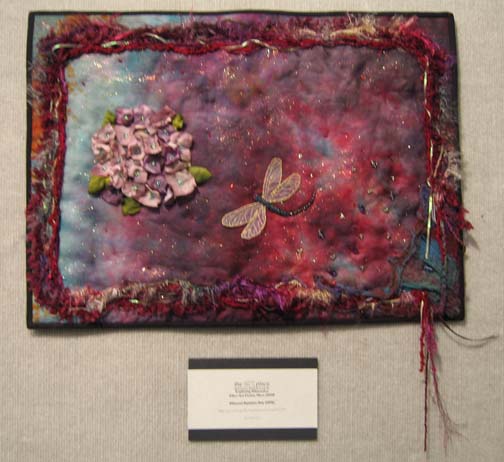
Fairy Grandmother’s Hat by Ann Quandee
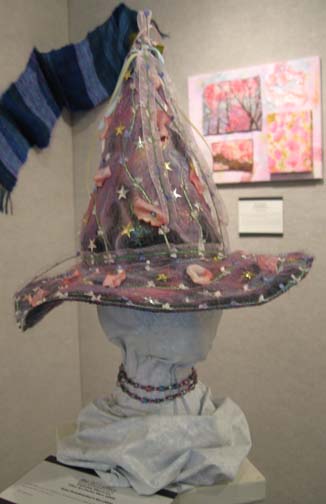
The Sweet By and By by Ann Quandee
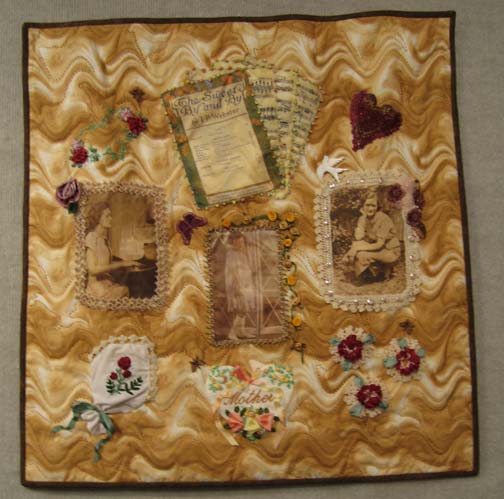
Treasures from the Earth by Ann Quandee – The amoeba shapes in the middle are heavily beaded with seed beads, and the background has handmade utee fabric beads.

Coral Reef Sea Creatures by Hellenne Vermillion – Hellenne made these with pottery, silk, and wool roving. I don’t know that I have seen anyone else merge these kinds of elements together so delightfully.
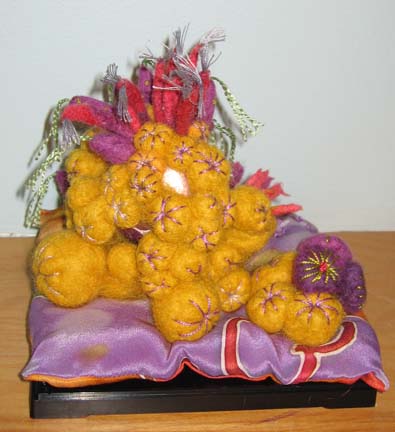
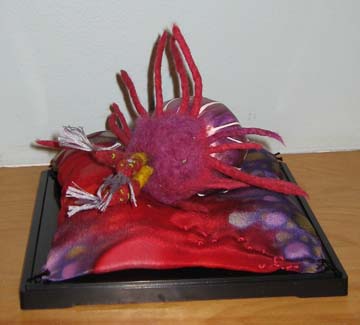
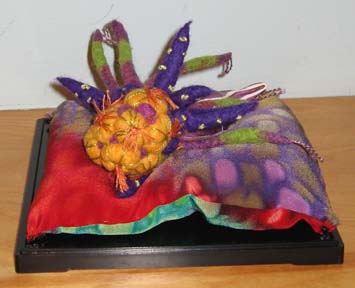
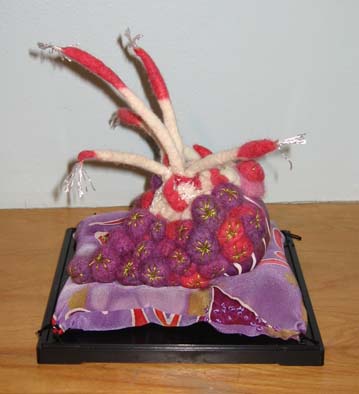
Sea Creatures Scarf by Hellene Vermillion

Exploring Dimension
0Fiber Art Fusion’s Exploring Dimension exhibit opens tomorrow at The Art Place in Marietta, GA. The reception is 7 – 9pm. I will have my piece The Price of Passage there.
I went to the hanging party yesterday — and it is a stunning exhibit. Margaret Betz and Rebecca Reasons have done an excellent job curating and hanging. Most of the artists in the show routinely work with the quilt as a flat surface. It is fun to see how everyone pushed themselves to create dimensional pieces using fabric. I feel honored to be included with such a talented group of artists.

The Price of Passage
2When my art group, Fiber Art Fusion, started talking about making our annual exhibit based on dimensional pieces, I was really excited — but I had no idea what I was going to do. Most ideas came & went, discarded for not being unique enough — and the one idea that stuck was to do a hanging bridge. Most all of my work is flat on the wall — but this would be sculptural using fabric as the primary medium.
So where have I been lately? Working frantically on this. I had most of the summer to think about the project, but very little time to actually work on it, and the exhibit is being hung on the first of next month.
But, thank goodness, I am finally done. It spoke to me today — and said that that was it — add no more.
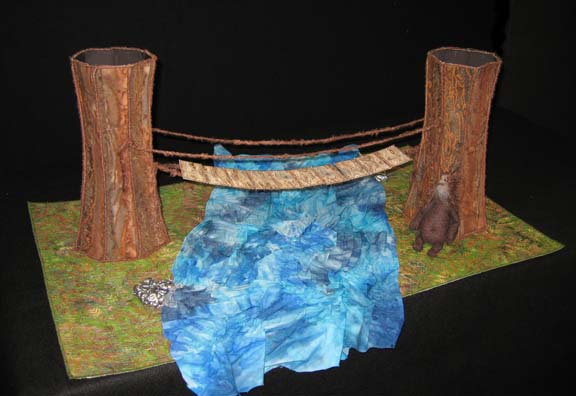
It is called The Price of Passage because of the bridge troll. How can you have a proper bridge in the middle of the forest without a troll — and of course, he’s going to expect payment for you to cross it.
I started with the trees. Our group had a great brain storming session with Sharon Ahmed in which she encouraged us to cut up paper and tape it together to come up with unusual shapes. I have also seen Terry Grant do the same thing when she is developing a pattern for a dimensional fabric teapot. At the end of school, I salvaged a sketch book of heavy white paper — most of it unused — and started cutting and taping. It took some time to figure out the size and the repetition of the pieces in order to get a nice round look.
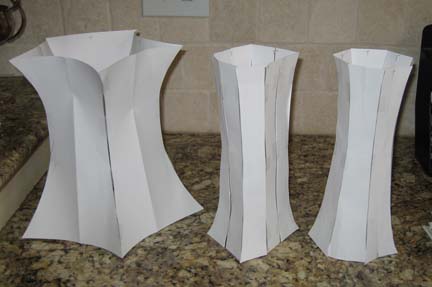
The first one on the left is my first attempt. Its diameter was too large and even though the paper was folded in the middle, helping to give a nice curve, I knew that wouldn’t translate to Peltex. For the 2nd tree, in the middle, I cut up the left & right halves — and the whole thing looked square. Adding one extra piece was a good idea — but didn’t really fix the problem enough. So for the 3rd tree (3rd times the charm), I drew the pattern with a left & right side & taped 7 of them together to give me a nice round shape. Voila — I had a pattern.
Then I cut out a side from the tree to make a template — fused fabric to both sides of Peltex — and then cut out the template from the Peltex. I wished I hadn’t done that so quickly. I then had to go back & add a fluffy brown yarn to cover the Peltex on the edges. It is much easier to mark the pattern on the fabric, sew the yarn onto the Peltex on that line, then cut it out & cover the edge with more thread. It gives you much better corners. I didn’t do that on the trees — but did remember to do that for the slats on the bridge.
Once I had 14 pieces, I started sewing them wrong sides together with a tight zigzag. This gave me a nice hinge that I think adds to the character of the trees — and it allowed me to sew them together by machine. I also added more fluffy yarn to the edges on the top & bottom of the trees before the final edge seam was sewn to give a cohesive look.
Then I made the bridge slats. They were done like the trees — with a minor change. I fused fabric to one side of the Peltex (which will be the back of the slats), marked the slats with a permanent marker, and then sewed on an O ring to the 2 short sides (thus saving me from sewing through Peltex by hand). Then I fused fabric to the front side of the Peltex and sewed a simple straight line — following the marked lines on the back side — so that I could see where to add the string on the front (I used a brown crochet thread) — which I added with a tight zigzag. The slats could then be cut out and the edges zigzagged with more thread.
Despite my eagerness, I realized at this point that the actual bridge had to be the last thing added. Again, I used a base of Peltex & fabric. By adding the back fabric first, I could sew on the finishing label by machine — and then fuse the fabric to the top.
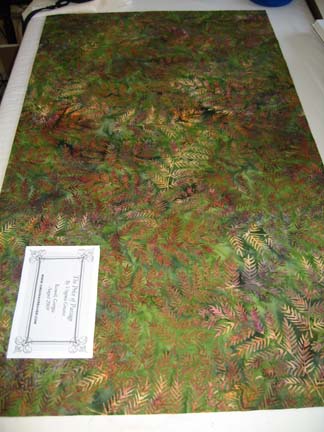
Then I took a great mottled blue hand-dyed fabric, covered the back with fusible, scrunched it up, and fused it on the base with lots of wrinkles left on top.
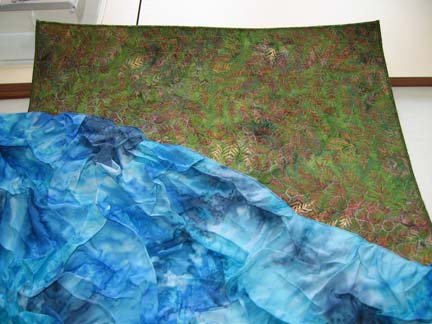
Then the base had to be quilted. Choosing quilting can be difficult, so I turned to my notebook and starting playing with ideas. (I’m a great fan of Dijanne Cevaal and am a big follower of her quilting techniques — guess it shows.)

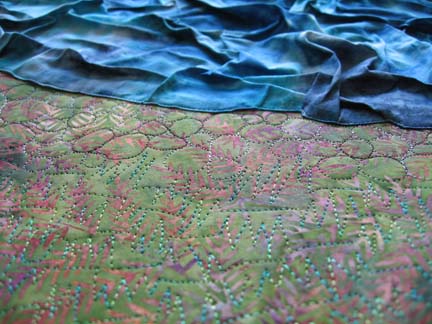
I don’t have a picture of it, but I used a metallic thread for the waves in the water. It was VERY challenging. I used a 100 Topstitch and really low tension — but it was difficult to keep the metallic thread from breaking when I was free motion quilting through Peltex and four layers of fused fabric.
Then I had to add the trees. No hope at this point but to sew them on by hand. I taped them down so they wouldn’t wiggle too much. I put on one of those sticky “thimble” sheets on my middle finger, but the needle kept puncturing it — and my finger. Then I had to wait & heal a few days.
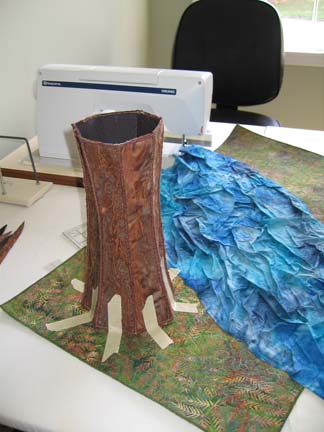
When the pain subsided, I added some metallic silver tulle and Tyvek that I had bubble melted and painted pewter.
My final addition before the bridge was the troll. I had been thinking about him all along, and in his first incarnation, he was wired (which was new to me) — but I had to discard him because he was out of scale for the piece. I don’t have a lot of experience making dolls, but after having spent some time reading Susanna Oroyan’s book Anatomy of a Doll, I knew that I couldn’t make too complicated a doll in the size that it needed to be in order to fit the rest of the piece. He also couldn’t be pretty — which was a strange thing for me. As artists, I think most of us try to make our work appealing, but a troll shouldn’t be too appealing. I drew out a main shape which included the legs, a different pattern for the arms, and a side view pattern of the head so that I could give him a nose and chin. He is my first attempt at needle sculpting a doll. He has beads for eyes, perle cotton thread details, gray wool felted on for the beard, and brown eyelash yarn for the hair.
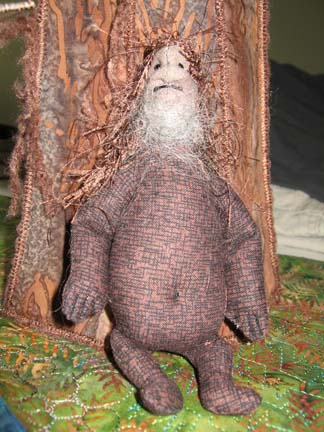
I would have liked him to have been wired and had more detailed hands, but he is very small and for me, it made more since to hinge him with a sewn line for the elbows, legs, and fingers.
The bridge was last. I strung 2 rows of fluffy brown yarn (same used on the trees) through the O rings on the back of the slats. I also added O rings on the side of each tree. Then I tied the string to each O ring — which sounds easy — but getting the tension just right was challenging. Too much pull on one side or the other, and the slats would twist or dip. Once it was done, I had to have handrails, so I added more O rings to the trees & more yarn tied to each end.
The Exploring Dimension Exhibit will be held at The Art Place in Marietta, GA this September 2009.
